Spruce Kings, Victoria Grizzlies battle into overtime



In partnership with Carrier Sekani Family Services, two UNBC professors have secured $1.5 million to pursue a five-year research project focused on strengthening mental wellness and suicide prevention among elders in B.C.’s Northern Interior.
The project will build on the work Dr. Henry Harder and Dr. Travis Holyk have carried out over the past decade when they looked at mental health wellness in Indigenous youth and young adults.
Holyk said they will be taking a “strengths-based approach that acknowledges and supports the importance of revitalizing Carrier and Sekani culture.” Indigenous research methodology will be used as the framework for all phases of the project.
“What sets Indigenous methodology apart is that it starts and ends with community,” said Harder. “It means working with community members who help us to identify the project priorities and also point to the best ways to uncover the information needed to find solutions and best outcomes.
“Basically, it puts the community ahead of the researcher, and we only pursue activities that directly benefit the community.”
The project will implement and evaluate intervention across member nations of Carrier Sekani Family Services. It will also seek to share the suite of materials created through the study with other First Nations communities.
Holyk is the CSFS’s executive director of research in primary care and strategic services and an adjunct professor at UNBC. Harder is a psychology and health sciences professor, and the Dr. Donald B. Rix B.C. Leadership Chair for Aboriginal Environmental Health.
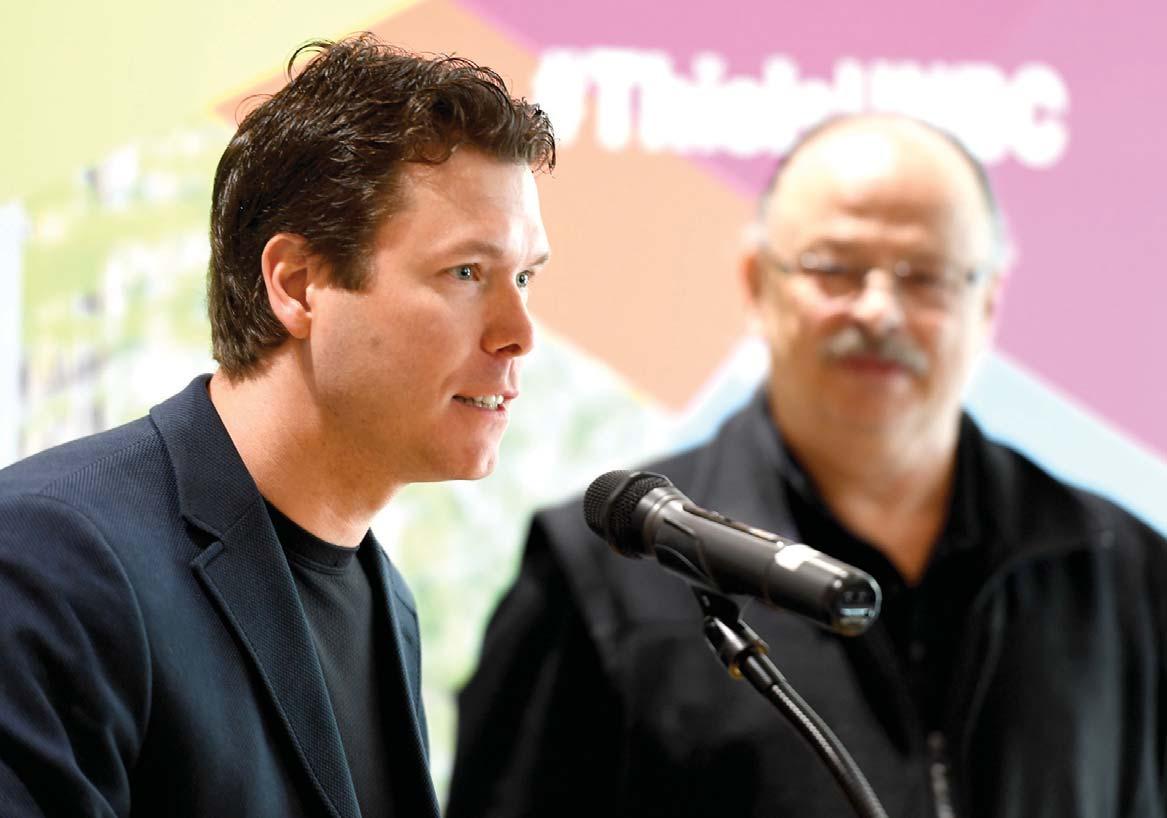
The funding, announced Tuesday, is provided through the Institute of Indigenous Peoples’ Health, part of the Canadian
and

A long-awaited conversion of an old downtown-area motel into affordable housing is nearing completion.
As workers carry out the finishing touches, the first of the tenants have begun moving into what was once the Economy Inn but is now known as Olive’s Branch on Third Avenue at Edmonton Street
City council approved rezoning for the purpose in November 2017.
The Association Advocating for Women and Children is managing the site, which will give people with mental health and addictions challenges the support they need within their own homes at rental rates they can afford.
The provincial government put $4 million towards purchasing and renovating the building.
“Having a supportive environment with safe, secure housing can help people stabilize and

begin rebuilding their lives,” Municipal Affairs and Housing Minister Selina Robinson said in a news release issued Tuesday.
“These new homes are going to provide crucial support to people living in poverty, experiencing homelessness, and those dealing with mental-health and addictions challenges.”
The building features 28 suites with private washrooms and small kitchenettes, as well as communal dining and laundry areas and will be staffed around the clock, seven days a week.
Residents pay a monthly rent of $450, which is the $375 social assistance shelter allowance provided by the provincial government to people experiencing homelessness, plus $75 for cable, internet, laundry and one meal per day.
When residents are ready to move into independent housing, staff will help them view apartments and work with landlords to support stable tenancies.
“These 28 new homes represent safety and security for too many who have never known it,” AWAC executive director Connie Abe said in the release. “Helping house our community’s most marginalized citizens will go a long way in helping them rebuild their lives.”
Renovations included upgrades to the water service, sprinkler system and fire alarm system installation, improved lighting, roofing and a common kitchen for residents.
According to the 2018 Homeless Count, 129 individuals in Prince George were homeless. Of these, 79 per cent are Indigenous.
Under its new Building B.C. programs, the provincial government has committed to create an additional 105 affordable housing units in Prince George, including 50 units for Indigenous peoples and 55 units of transition housing for women.
Currently, B.C. Housing supports 156 other housing units throughout Prince George.
Citizen staff
As warmer weather returns to parts of the province affected by last summer’s wildfires, the B.C. Wildfire Service is advising British Columbians that some hot spots could reemerge due to what are called “overwintering” fires.
An overwintering fire can occur when a wildfire that burned deep underground last year has continued to smoulder all winter long. Given the extent and intensity of many wildfires in the summer of 2018, some of these residual hot spots could flare up with the arrival of warmer and drier weather this spring. Most overwintering fires will occur well within the original fire’s perimeter. Many areas near communities where wildfires burned last year are being actively patrolled by firefighters and scanned using thermal imaging technology.
It is standard practice for the B.C. Wildfire Service to monitor previous wildfire sites to ensure that any flare-ups from overwintering fires are located and suppressed if necessary. However, members of the public are encouraged to report any wildfire or smoke they see, even if it is located within the perimeter of a previous fire. To report a wildfire, unattended campfire or open burning violation, call 1 800 663-5555 toll-free or *5555 on a cellphone.

From Prince George provincial court, March 25-29, 2019:
• Lloyd Peter Alexis (born 1968) was sentenced to 22 days in jail and six months probation for three counts of breaching probation, two committed in Prince George and one in Vanderhoof. Alexis was in custody for three days prior to sentencing.
• Joseph Patrick Courtoreille (born 1990) was sentenced to eight days in jail and one year probation for possession of stolen property under $5,000 and breaching probation. Courtoreille was in custody for two days prior to sentencing.
• Perry Robert Wells Hogan (born 1990) was sentenced to nine days in jail for willfully resisting or obstructing a peace officer and two days for breaching probation. Hogan was in custody for one day prior to sentencing.
• Jonathon Anthony Williams (born 1985) was sentenced to three days in jail for breaching probation. Williams was in custody for one day prior to sentencing.
• Paul Frank Alec Jr. (born 1988) was sentenced to 22 days in jail for
assault and breaching probation and to seven days in jail for causing fear of injury or damage. Alec Jr. was also sentenced to two years probation on the counts and ordered to provide a DNA sample on the assault. Alec Jr. was in custody for 12 days prior to sentencing.
• Robert Norton Allaire (born 1937) was fined $500 plus a $75 victim surcharge for driving while driver’s licence is suspended under the Motor Vehicle Act.
• Derik George Derksen (born 1990) was sentenced to one year probation for theft $5,000 or under.
• Thomas Glenn Ferris (born 1965) was sentenced to one year probation with a suspended sentence for theft $5,000 or under.
• Murphy John George (born 1983) was sentenced to 37 days in jail for possessing weapon for dangerous purpose and wilfully resisting or obstructing a peace officer and to 30 days for mischief $5,000 or under and to 18 months probation on the counts. George was in custody for 13 days prior to sentencing.
• Carmen James Alexander Hodgson-McKay (born 1990) was
sentenced to one year probation for two counts of breaching probation.
• Raymond Paris Robert Lorrain (born 1979) was sentenced to 21 days in jail, prohibited from driving for two years and fined $1,000 plus $150 in victim surcharges for two counts of driving while prohibited or licence suspended under the Motor Vehicle Act.
• Jarl Sundve (born 1944) was fined $2,000 plus a $300 victim surcharge for fail to cancel species licence immediately under the Wildlife Act Hunting Licence Regulation.
• Shelina Ann Barrett (born 1990) was sentenced to jail time served and 18 months probation for being unlawfully in a dwelling house and to one day in jail for breaching an undertaking or recognizance. Barrett spent a total of 14 days in custody prior to sentencing.
• Ryan Samuel Klukas (born 1996) was sentenced to nine days in jail and one year probation for uttering threats, committed in Kitimat. Klukas was in custody for one day prior to sentencing.
• David John Stewart (born 1960) was prohibited from driving for 18
Citizen staff
A community engagement session on two draft agreements to conserve southern mountain caribou populations will be held in Prince George.
It is set for Tuesday at the Civic Centre, from 5:30 to 9:30 p.m.
The event will give the public a chance to provide their feedback on the items –one between B.C. and Canada that sets a framework for cooperation between the two governments and the other between B.C., Canada, West Moberly and Saulteau First Nations that proposes specific habitat protection and restoration measures to recover the central group herds. Staff from the provincial and federal
governments will share information about the draft agreements and will be available to answer questions.
Staff from the Saulteau and West Moberly First Nations will attend.
Sessions will also be held in Mackenzie on April 10 at the Mackenzie Recreation Centre, in Quesnel on April 11 at the Quesnel and District Seniors’ Centre and in Williams Lake on Monday, at the Cariboo Memorial Recreation Complex.
All will run from 5:30 to 9:30 p.m.
The feedback collected will help inform the final agreements.
Overviews of the draft agreements, a feedback form, maps and general information, are available online: https://engage. gov.bc.ca/caribou/section11agreement/.
months and fined $1,200 for
• Austin Charles Hunt (born 1995) was sentenced to five months in jail for assault causing bodily harm, to three months in jail for assault, to 30 days in jail for breaching a recognizance and to 14 days in jail for two counts of breaching probation. Hunt was also sentenced to 18 months probation and assessed a threeyear firearms prohibition. Hunt was in custody for 137 days prior to sentencing.
• Tyler Curtis Gurskey (born 1979) was sentenced to 136 days in jail for personation with intent to gain advantage and possession of stolen property under $5,000, to 45 days in jail for breaching probation, all committed in Prince George, and to 30 days in jail for breaching probation, committed in Williams Lake. Gurskey was also sentenced to two years probation on the Prince George counts. Gurskey was in custody for 27 days prior to sentencing.
• Michael Nicholas Kirkpatrick (born 1967) was fined $500 for breaching an undertaking or recognizance.
• Rebecka Susanne Rahkola (born 1989) was sentenced to time served for breaching probation, committed in Kamloops. Rahkola was in custody for five days prior to sentencing.
• Cameron Gregory Boyes (born 1999) was sentenced to three years probation with a suspended sentence and issued a 10-year firearms prohibition for two counts of possession for the purpose of trafficking under the Controlled Drugs and Substances Act.
• Kale Raymond Comeau (born 1985) was sentenced to 17 days in jail for breaching probation and to 10 days in jail and two years probation for possessing of stolen property and willfully resisting or obstructing a peace officer. Comeau was in custody for one day prior to sentencing.
• Jared Taylor Joseph (born 1995) was sentenced to time served and one year probation and issued a two-year firearms prohibition for assault causing bodily harm and to time served for breaching probation, committed in Prince George and Smithers. Joseph was in custody for 32 days prior to sentencing.
Citizen staff
Applications are now being accepted from those interested in volunteering for the 2020 World Women’s Curling Championship.
They will be needed for a range of roles, including set-up and takedown, working in the stands during games and behind the scenes at various checkpoints.
Volunteers will also be needed for a variety of media roles and assisting in keeping lounges stocked with refreshments and food.
Each volunteer must commit at least
30 hours to the event and pay a $100 rewards fee, which helps cover the cost of an official volunteer uniform and handbook, limited edition volunteer pin, access to the venue when not on shift (space permitting), access to the Patch beer garden with live entertainment and an invitation to the volunteer appreciation party. Set for March 14-22 at CN Centre, the tournament will feature 13 teams, including Team Canada – the winner of the 2020 Scotties Tournament of Hearts in Moose Jaw, Sask. To become a volunteer, visit: volunteer. curling.ca/2020worldwomen.



The Tsilhqot’in First Nation have scored at least a temporary victory in an ongoing back-and-forth fight in the courts against the New Prosperity mine.
The B.C. Supreme Court has granted an injunction application by the Tsilhqot’in that will prevent Taseko Mines from doing exploratory drilling – drilling that was just last month upheld by the B.C. Court of Appeal.
The Tsilhqot’in will now seek leave to appeal the appeal court decision to the Supreme Court of Canada.
“The injunction prohibits (Taseko) from carrying out the drilling program until the Supreme Court of Canada decides whether to hear an appeal of British Columbia’s decision to approve the drilling program,” the Tsilhqot’in said in a press release.
The Tsilhqot’in have been in a pitched battled with Taseko for years over the New Prosperity mine.
The B.C. government issued an environmental certificate for the proposed copper mine, but the federal government, through the Canadian Environmental Assessment Agency (CEAA), refused to issue a certificate not once, but twice.
Taseko is still waiting for a decision on its challenge to that decision through the Federal Court.
It sought two judicial reviews, saying the federal government breached principles of administrative fairness, and that it relied on faulty information supplied by the Natural Resources Canada on the potential for a tailings pond above Fish Lake to seep.
Meanwhile, Taseko said it was obliged under the conditions of the provincial certificate to have the work on the mine substantially started before a 2020 expiration date. Some of the work that has to occur is geotechnical work on a proposed tailings pond.
“As part of the Mines Act permitting process, we would be required to gather more information about the performance characteristics of the bottom of that tailings pond,” Taseko spokesperson Brian Battison said. “That’s what we’re planning to do. It’s drilling holes, and it’s digging test pits.”
Because there is a sunset clause in the original certificate issued by the province, Taseko applied for a drilling permit from the province and received one, despite the fact the CEAA has denied the project an environmental certificate.
The Tsilhqot’in challenged that decision, but the B.C. Supreme Court upheld the provincial government’s decision to issue a notice of work allowing for the geotechnical work to take place.
The Tsilhqot’in appealed the lower court decision, but at the beginning of March, the B.C. Court of Appeal upheld the lower court ruling.
And now the B.C. Supreme Court has granted an injunction against the drilling permit upheld by the Appeal Court, pending the Tsilhqot’in’s application to the Supreme Court of Canada.
In 2014, the Tsilhqot’in won a landmark legal victory, when the Supreme Court of Canada confirmed Tsilhqot’in title to some of the territory claimed by the First Nation as unceded territory. It also confirmed tradition aboriginal rights to hunt, trap and catch wild horses in a wider area beyond the title land.
Earlier court rulings have found that the Tsilhqot’in do have aboriginal rights, even if not title, in the area where the mine is proposed. The question for the Supreme Court of Canada may be whether the proposed New Prosperity mine would infringe those rights.
While the saga plays out in the courts, Battison said Taseko can, and will, apply to the provincial government for an extension to its original certificate.
“Our position remains unaltered,” Battison said.
“We will see this through to the end. The New Prosperity deposit is just far too important for British Columbia to ever give up on.”
The Tsilhqot’in’s position also remains unaltered.
“It is still unfortunate that we, collectively, spend time and resources on exploration for a mine proposal that cannot proceed,” Russell Myers Ross, vicechairman of Tsilhqot’in National Government, said in a news release.
Amy SMART Citizen news service
HOUSTON — Members of a First Nation in northern British Columbia who oppose a planned pipeline through their traditional territory say they will build a new camp to block its path.
A statement posted on Facebook on Tuesday says the Likhts’amisyu clan of the Wet’suwet’en First Nation is asserting its sovereignty by creating “a new, permanent land reclamation on their territory.”
It says the camp will be “strategically located in order to impede the ability of the Coastal GasLink corporation to force their pipeline through Wet’suwet’en land.”
The Coastal GasLink pipeline would transport natural gas from northeastern British Columbia to LNG Canada’s export terminal on the coast in Kitimat.
The company says it has signed agreements with all 20 elected First Nations councils along its path but the hereditary clan chiefs of the Wet’suwet’en First Nation say the project has no authority without their approval.
In January, RCMP enforced an injunction against members of the nation’s Gidim’den clan and supporters who built a blockade along a logging road toward the project’s work site.
The Unist’ot’en camp, led by members of another clan, was conceived as a re-occupation of the land and has been a focal point of resistance against Coastal GasLink and other proposed oil and gas projects for almost 10 years.
“It’s important that people realize this fight is far from over,” the statement says.
“The events of December and January should be regarded as one phase in a struggle that has been going on for a decade. A new phase of struggle will begin in the spring of this year, and it may prove to be the decisive one.”
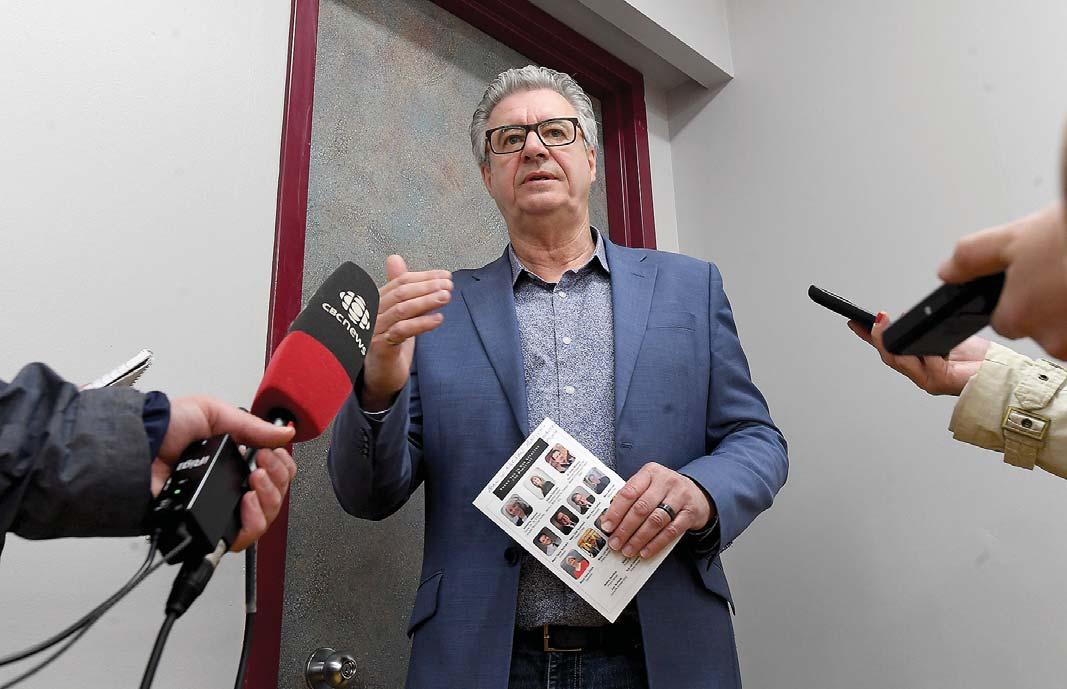
Mark NIELSEN Citizen staff mnielsen@pgcitizen.ca
Emergency management, social and economic balance, and opportunities emerging from the provincial government’s CleanBC initiative were the topics tackled when more than 30 mayors from across the province converged on Prince George on Monday and Tuesday.
Along with meeting every September at the Union of British Columbia Municipalities convention, mayors also hold a caucus at about this time every year.
“I was very interested in hosting it here so I put up my hand and said we’d
be more than prepared,” Mayor Lyn Hall said Tuesday following the gathering at the Civic Centre.
The discussion on emergency management was not limited solely to wildfires, Hall said, and noted communities in the Lower Mainland and on Vancouver Island are concerned with earthquakes and tsunamis.
On social and economic prosperity, Hall said the city has more than $70 million worth of development downtown “yet we still have social issues that we’re dealing with – mental illness, drug addiction.”
“On that dichotomy, we had a great conversation because every municipality is facing it. How do we, as munici-

palities, deal with it.
“And that involves the province, it involves the feds, it involves B.C. Housing, it involves social service agencies across each municipality.”
On CleanBC, mayors talked about ways to make the most of the provincial government’s strategy to deal with climate change.
On that note, mayors were given tours of the city’s downtown energy system, the Wood Innovation and Design Centre and the Wood Innovation Research Lab.
Hall said the talks were part of an overall strategy to develop positions mayors can take as a group to the provincial and federal governments.


Damian PALETTA, Josh DAWSEY Citizen news service
WASHINGTON — Senior White House officials are exploring ways to exempt commercial trade from U.S. President Donald Trump’s threat to shut down the U.S. border with Mexico, three people briefed on the discussions said, amid warnings that blocking the flow of goods between the two countries would have severe consequences for the U.S. economy.
In brief remarks, Trump on Tuesday again threatened to close the border but would not definitively say whether he would do so, and he has not divulged his plans even to some of his closest aides. But the White House is bracing for the possibility and internal planning has reached an advanced stage, according to the three people, who spoke on condition of anonymity because they were not authorized to disclose the deliberations.
Trump plans to visit the Mexico border Friday in California, where some aides are bracing for a possible announcement. Even though White House officials had begun deliberating, business groups expressed skepticism that any plan might work in a way that limited potential problems.
As Trump has escalated his threats to close the border in recent days, top aides have launched a two-pronged strategy in preparation for a decision.
One approach has been to study ways to minimize the economic impact of shutting the border with the United States’ secondlargest trading partner, in part by allowing trains and trucks to continue bringing goods across the border.
The second prong has included a series of internal warnings to Trump about what might happen if the border is sealed, messages delivered by National Economic Council Director Larry Kudlow and Kevin Hassett, head of Trump’s Council of Economic Advisers.
“We’re watching it and looking for ways to allow the freight passage,” Kudlow said in an interview with CNBC. “Some people call it truck roads. And there are ways you can do that, which would ameliorate the breakdown in supply chains.”
Many U.S. manufacturers rely on the import of parts and equipment from Mexico in order to complete production and ship machinery, cars or other goods.
At the Brownsville, Texas, border crossing last year, nearly 800 trucks crossed the border each day, according to data from the Department of Transportation.
Senate Republicans have also begun sounding alarms about what might happen if Trump follows through on his threat, focusing on the economic impact because that often resonates with Trump.
“Closing down the border would have a potentially catastrophic economic impact on our country, and I would hope that we would not be doing that sort of thing,” McConnell told reporters Tuesday.

Sen. John Kennedy, R-La., said shutting down the border could cost the U.S. economy $1 billion or $2 billion each day.
Trump’s vow to close the border comes after several tense months in U.S.-Mexico relations. The Mexican government last year agreed to restructure the North American Free Trade Agreement after Trump threatened to rip up the 1994 deal. But the new agreement has bogged down in Congress, in part because Democrats want more assurances on how certain provisions will be enforced.
And Trump earlier this year declared the situation at the Mexico border to be a national emergency, a designation that he has said allows him to redirect taxpayer money to expedite the construction of a wall.
But the recent surge of families and other migrants trying to cross into the U.S. has led Trump to call for even more immediate steps, with his focus in recent days shifting to closing down the border.
The president said on Tuesday that he is more focused on security concerns than the impact closing the border would have on the U.S. economy.
“Sure it’s going to have a negative impact on the economy,” he told reporters, while saying it was possible that only certain sections of the border could be closed. “Security is more important to me than trade.”
Trump has also been told by some advisers that it would be extremely difficult to operationally shut down the border, but he has told them to move forward with looking at ways to achieve the feat.
As of Tuesday afternoon, U.S. Customs and Border Protection officials had not been instructed to prepare for the possibility of shutting down the border, according to a DHS official who spoke on condition of ano-
Citizen news service
VICTORIA — The British Columbia government introduced legislation Tuesday aimed at preventing tax evasion and money laundering by shining a spotlight on anonymous real estate owners hiding behind shell and numbered companies.
Finance Minister Carole James said the proposed Landowner Transparency Act would create Canada’s first public registry of property owners to compel corporations, trusts and partnerships to disclose the owners of the land they currently have and are purchasing.
“It will require corporations, trusts and partnerships to be able to include the information around who is an owner of the
land, just as citizens do with they register (at the land titles office),” James said at a news conference after presenting the bill in the legislature.
She said a lack of transparency in some aspects of real estate ownership is one of the challenges the government faces with money laundering and tax fraud. James noted that a 2016 report by Transparency International Canada indicated nearly one-third of the 100 most valuable residential properties in Metro Vancouver were owned by shell companies. The group is the Canadian division of Transparency International, an anti-corruption, non-government coalition that looks at global corruption and offers legal reforms to fight it.

nymity to describe internal deliberations. DHS Secretary Kirstjen Nielsen cut short a trip to Europe this week and returned to Washington early Tuesday morning to manage the agency’s response at the border, DHS officials said.
At least 545 blue-uniformed CBP officers have been redeployed to help Border Patrol agents detain and process Central Americans families arriving in record numbers.
Diverting those officers and other resources away from U.S. ports of entry along the Mexico border is already leading to increased wait times and logjams for commercial trucks and vehicles entering the United States.
Wait times for vehicles trying to cross the border in Brownsville extended to three hours on Monday, a senior DHS official told reporters Tuesday. At the Otay Mesa crossing in San Diego, one of the border’s busiest for cargo, 150 commercial trucks were stuck in line Monday, officials said.
Despite the logistical and economic concerns, White House aides have said this week that Trump is serious about closing the border even if the timing remains unclear.
On Tuesday, White House press secretary Sarah Sanders softened Trump’s threat to close the southern border by the end of the week, saying that such a move was not the president’s “first choice” and that he does not have a “specific timeline.”
“Eventually it may be the best decision that we close the border,” Sanders told reporters at the White House, adding that Mexico has taken some concrete steps to slow the flow of migrants coming into the United States, as Trump has demanded.
“He’s hoping that Mexico will continue to step up, like we’ve seen them do over the
last couple of weeks,” Sanders said. “We hope that that continues, and that we can work with them so we don’t have to (close the border).”
Completely shutting down the U.S. border with Mexico, as Trump has threatened, could halt all U.S. automotive manufacturing within a week, affecting at least one million jobs, said Kristin Dziczek, vice president of industry, labor and economics at the Center for Automotive Research. She said virtually all U.S. auto production relies on some key parts from Mexico or Central America, and these products are brought into the United States on trucks or trains.
“The building of vehicles requires 100 per cent of the parts to be there,” she said, adding that seat belts, engines, transmissions and wiring harnesses are all brought across the U.S. border.
The U.S. Chamber of Commerce began raising alarms last week about Trump’s threat to shut down the border, saying it could have a crippling effect on the U.S. economy. But Trump has so far refused to back down.
Mexico is the U.S.’s second-largest trading partner, meaning that any disruption at the U.S. border could have immediate consequences on the economy. U.S. companies imported $314.3 billion in goods from Mexico in 2017, according to the Office of the U.S. Trade Representative. And U.S. companies exported $243.3 billion in goods.
The top imports from Mexico are automobiles, electrical machinery, medical instruments and mineral fuels. The U.S. also imports more agricultural goods from Mexico compared with any other country, with $11.5 billion in fresh fruit and vegetables brought into the U.S. each year. — see related story, page 8
an agreement struck between the bloc and May late last year.
The House of Commons has also failed to find a majority for any alternative plan in two days of voting on multiple options.
LONDON — With Britain racing toward a chaotic exit from the European Union within days, Prime Minister Theresa May veered away from the cliff-edge Tuesday, saying she would seek a further delay to Brexit as U.K. politicians sought a compromise solution to the crisis.
May made the announcement after the EU’s chief negotiator warned that a disruptive and costly Brexit was likely unless Britain broke the impasse that has paralyzed the government and Parliament.
After failing repeatedly to win Parliament’s backing for her Brexit blueprint, May said the country needed “national unity to deliver the national interest.”
Following the defeat of the government’s plan and a range of lawmaker-written alternatives, May said Britain would need a further delay to its EU departure, currently scheduled for April 12. She offered to hold talks with opposition Labour Party leader Jeremy Corbyn in an attempt to find a compromise solution.
“This debate, this division, cannot drag on much longer,” May said in a televised statement from 10 Downing St. after an all-day Cabinet meeting.
European Council President Donald Tusk gave a cautious welcome to May’s change of course.
“Even if, after today, we don’t know what the end result will be, let us be patient,” he tweeted – a suggestion the EU would wait for Britain to present a clear plan.
Earlier, EU negotiator Michel Barnier offered a downbeat assessment of the situation.
“As things stand now, the no-deal option looks likely. I have to tell you the truth,” Barnier said in Brussels.
Barnier said “we can still hope to avoid it” if London produced a breakthrough before an April 10 EU summit.
The leaders of the EU’s 27 remaining countries have given the U.K. until April 12 to leave the bloc or to come up with a new plan, after British lawmakers thrice rejected
May’s statement came after a seven-hour meeting of her fractious Cabinet, which is split between supporters of a “soft Brexit” that keeps close economic ties with the EU, and Brexiteers who believe a no-deal exit is better than compromising.
May’s words seemed to indicate that she was veering away from the possibility of a no-deal Brexit – but also that she has not given up on her own withdrawal plan.
Her plan is to seek approval for the legally binding agreement – which sets out in detail the terms of Britain’s departure from the EU – after securing cross-party political support for a vision of future ties between the U.K. and the bloc.
If she and Corbyn fail to reach agreement, May said Parliament would get to vote on a range of options – and the government would be bound by the result. It is the first time she has committed to following the instruction of lawmakers.
May didn’t indicate how long an extension she would seek from the EU, though she said she hoped Britain could pass the agreement by May 22, in time to avoid participating in elections for the European Parliament.
Corbyn said he would be “very happy” to sit down with May, even though “so far she hasn’t shown much sign of compromise.”
Corbyn said Labour would present May with its conditions for Brexit, which include a close economic relationship with the bloc through a customs union, maintaining high environmental standards and protecting workers’ rights.
Businesses have warned that the economic impact in Britain could be devastating. Ford of Europe chairman Steven Armstrong said “a no-deal Brexit would be a disaster for the automotive industry in the U.K.”
Edwin Morgan, interim director general of business group the Institute of Directors, said May’s statement was “a welcome step towards compromise,” though there remained obstacles ahead.
OTTAWA — Jody Wilson-Raybould and Jane Philpott have both been kicked out of the Liberal caucus, Prime Minister Justin Trudeau said Tuesday, moments after their fellow government MPs had gathered on Parliament Hill for an emergency meeting to determine their future with the party.
Wilson-Raybould, whose explosive allegations of political interference by the Prime Minister’s Office appear to have deeply imperilled Liberal hopes of holding on to power in this fall’s federal election, wrote to her fellow - now former – caucus members earlier in the day in hopes of convincing them to let her stay.
But just minutes into Tuesday’s hastily convened meeting, Wilson-Raybould, who stepped down from Trudeau’s cabinet in February after he shuffled her out of the coveted justice portfolio, made it clear via Twitter that the letter hadn’t worked.
“I have just been informed by the prime minister of Canada that I am removed from the Liberal caucus and as the confirmed Vancouver Granville candidate for the Liberal Party of Canada in the 2019 federal election,” she tweeted.
Minutes later, reporters and cameras were ushered into the caucus room to listen to Trudeau announce that both Wilson-Raybould and Philpott were gone.
“The trust that previously existed between these two individuals and our team has been broken,” Trudeau told caucus members.
“It’s become clear that Ms. Wilson-Raybould and Dr. Philpott can no longer be part of our Liberal team.”
It’s the latest dramatic twist in the turmoil that has roiled the top ranks of the Trudeau government for weeks, fuelled by allegations that Wilson-Raybould was improperly pressured by the Prime Minister’s Office to intervene in the criminal prosecution of Montrealbased engineering firm SNC-Lavalin.
And it comes on the heels of a fresh uproar over a key phone conversation between the ex-minister and former Privy Council clerk Michael Wernick, the country’s top bureaucrat – a conversation Wilson-Raybould secretly recorded.
That recording was released Friday as part of her evidence of what Wilson-Raybould calls an intense pressure campaign to persuade her to override a decision to deny SNC-Lavalin a remediation agreement, which would allow the engineering giant to avoid criminal proceedings on corruption and fraud charges.
In the weeks following Wilson-Raybould’s resignation, caucus had grown divided over
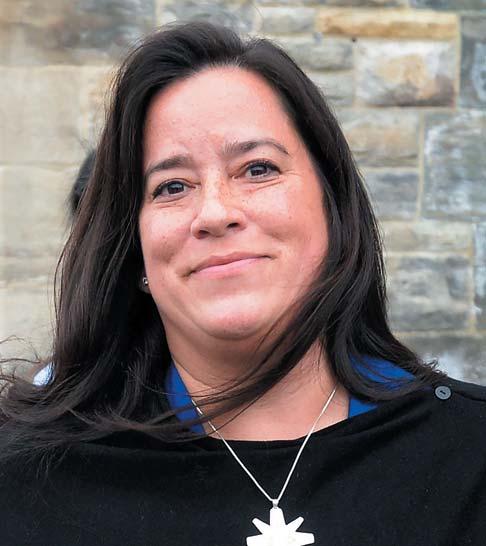
the question of whether she and Philpott should be allowed to remain in caucus.
Trudeau himself had initially suggested he would be willing to let them stay.
But Friday’s release of Wilson-Raybould’s 17-minute phone conversation with Wernick – and the fact she recorded it – appeared to tip the scales.
“We’ve taken every effort to address their concerns, and ultimately, if they can’t honestly say that they have confidence in this team ... then they cannot be part of this team,” Trudeau said.
“If a politician secretly records a conversation with anyone, it’s wrong. When that politician is a cabinet minister secretly recording a public servant, it’s wrong. And when that cabinet minister is the attorney general of Canada, secretly recording the clerk of the Privy Council, it’s unconscionable.”
“I know many of you are angry, hurt, and frustrated. And frankly so am I, and I can only speak for myself,” Wilson-Raybould wrote in her letter to caucus members.
“I am angry, hurt, and frustrated because I feel and believe I was upholding the values that we all committed to. In giving the advice I did, and taking the steps I did, I was trying to help protect the prime minister and the government from a horrible mess.
“I am not the one who tried to interfere in sensitive proceedings, I am not the one who made it public, and I am not the one who publicly denied what happened. But I am not going to go over all of the details here again. Enough has been said.”
Toronto MP John McKay, who was unmoved

by Wilson-Raybould’s letter, said he’s dismayed by her behaviour and believes she and Philpott are “joined at the hip.” Fellow MP Judy Sgro agreed the letter is “too little, too late.
Infrastructure Minister Francois-Philippe Champagne criticized Wilson-Raybould’s ethics, saying he had never recorded any conversations he had while working as a lawyer. Tourism Minister Melanie Joly called it “fundamentally wrong.”
In the call, Wernick repeatedly asks WilsonRaybould why she was not using all the tools at her disposal on the SNC-Lavalin case. She pushes back, saying she would not override the decision of the director of public prosecutions to pursue a criminal prosecution against SNC-Lavalin for bribery and fraud related to its activities in Libya.
Wernick told her Trudeau was “quite determined” on the matter and would likely “find a way to get it done one way or another.”
In a written submission that accompanied the audio, Wilson-Raybould acknowledged recording the conversation was an “extraordinary and otherwise inappropriate step,” but said she felt it necessary to have an exact record of what was discussed.
Wilson-Raybould has said she believes she was moved out of Justice to Veterans Affairs as punishment for refusing to succumb to relentless pressure last fall from Trudeau, his senior staff, Wernick and others to intervene on SNC’s behalf.
She resigned from cabinet a month later.
Philpott followed suit in early March, citing a loss in confidence in the government’s handling of the matter.
VANCOUVER (CP) — The main campus of Langara College in south Vancouver was closed on Tuesday after several fires broke out in college buildings and a man was arrested. Police were called just before noon Monday and quickly determined that a suspect had allegedly entered the college with incendiary devices. One or more fires was reported before police say the man fled. At a news conference Monday night, Const. Jason Doucette confirmed a man in his 20s was arrested in Surrey by Metro Vancouver Transit Police about four hours after the fires were set. Doucette said officers recovered “two or three” devices that had allegedly been deliberately placed, and several fires occurred, but an estimate on the damage was not available. “There were actual fires throughout. Some devices did go off, some didn’t,” he said. No one was hurt in the incident.
LAKE COWICHAN (CP) — The father of a seven-year-old boy who was attacked by a cougar in a small lakeside community on Vancouver Island is crediting his wife’s quick actions for his son’s survival.
Kevin Bromley says his son Zach was playing in the family’s backyard in Lake Cowichan on Friday, when a cougar leapt toward him but banged into a fence before clawing its way through. Kevin says his wife Chelsea heard the fence rattle and looked out to see the cougar trying to drag her son away. She jumped down the back stairs and started trying to pry the animal’s jaws open, before it released its grip on his left arm and ran away.
Kevin says Zach is recovering at his grandparents’ house with gashes to his head, neck and arm.

When it comes to dealing with online hate speech, we’ve ended up in the worst of all possible worlds.
On the one hand, you have social media platforms like Facebook and Twitter that seem extremely reluctant to ban white supremacists and actual neo-Nazis, but enthusiastically enforce their own capricious terms of service to keep adults safe from such harmful things as the female nipple. That is, until something horrific happens, such as the Christchurch massacre, when they decide – after the fact – that some content needed to be banned.
This very much includes Facebook’s decision last week to ban white nationalist content, a move that critics have demanded for years and that Facebook could have introduced at any time.
On the other hand, you have democratic governments (leaving authoritarian countries like China out of the mix) that have become far too comfortable exerting behind-the-scenes pressure on platforms to remove content or withdraw their services in the absence of legislation or formal legal orders. Whether it’s pressure on companies to withdraw web-hosting and payments services from Wikileaks following the leak of U.S. diplomatic cables in 2010, or the documented influence of the American government to pressure companies like Google into supposedly “industry-driven” trademark enforcement efforts, govern-
ment regulation of speech is happening, but without any real accountability.
This reality is nowhere reflected in the debates over whether and/or how to regulate online speech. Instead of grappling with these basic facts, far too much of the debate over how to regulate social media is caught up in a U.S.-driven, libertarian-derived fever dream that sees all speech regulation as inherently problematic, cannot differentiate between liberal-democratic and totalitarian governments, and is obsessed with deploying technological tools to allow global platforms to deal with any problems.
In other words, governments are regulating speech, but not through democratic channels. Online platforms and internet service providers are regulating speech based on self-interested terms of service. That is, until the moment they decide to drop the banhammer.
The problem, to be crystal clear, is not that governments and these companies are regulating online content. All societies recognize that some kinds of speech are inherently destabilizing or harmful to individuals or specific communities. Child pornography is the most obvious example of this type of content.
Beyond such a straightforward example, different societies will draw different lines between acceptable and unacceptable content– think Germany’s ban on public Holocaust denialism – but every society does have a line.
Instead, the real problem – the one we ignore by focusing on the sideshow of whether speech should be regulated when
it obviously always is – is about who should draw a line that is inherently subjective, and that changes over time and across societies. It is, in short, an issue of accountability: are we happy with American companies, or governments engaged in shadowy pressure games, making these decisions?
In order to deal with both of these problems – decisions made by unaccountable, profit-seeking global giants, and clandestine pressure tactics from supposedly democratic governments – we need to bring decisions about what content should be regulated and how these decisions are made into the public sphere.
We have to ensure that decisions about what speech gets regulated are made by the people affected by these rules. That’s the whole point of democracy. What this means is that in the absence of a global government, we need to think nationally, because that’s where the accountability mechanisms are.
National regulation also respects the reality that countries have different social and political norms regarding speech. While the U.S. takes its free-speech absolutist stance from its First Amendment, for example, Germany recently instituted a law requiring social media platforms to remove hate speech or face steep fines.
Germany’s law may be controversial. However, it’s important to recognize that all efforts to regulate speech involve tradeoffs, but that these efforts are designed to respond to a legitimate societal need. Plus, given the explosion of murderous real-world consequences associated with
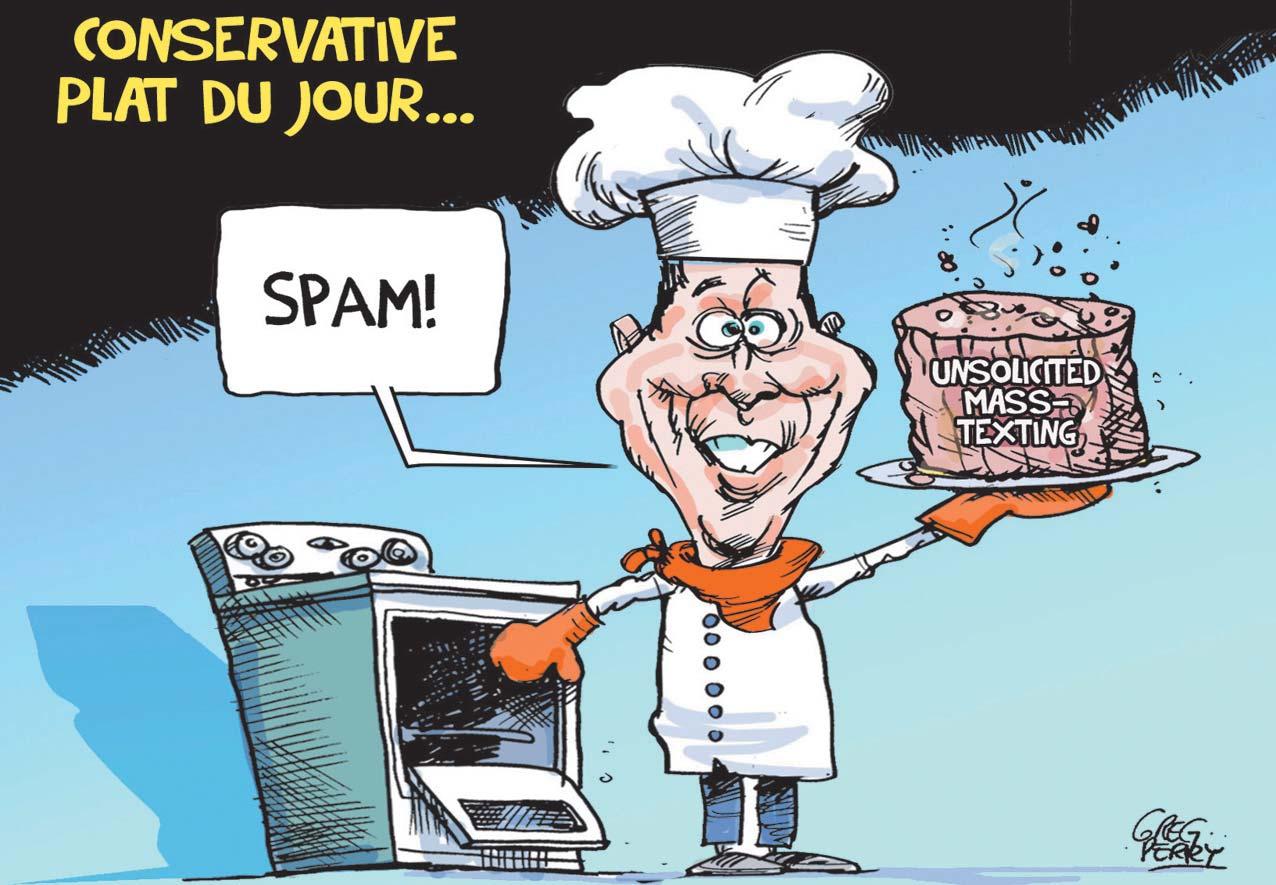
On my way home and listening to CBC, it came to my attention that Lisa Helps, the mayor of Victoria, has sent a letter to all the mayors in B.C. looking for support to launch a class action suit against the fossil fuel industry. Oh my – what bubble or different planet does Ms. Helps live on?
It is getting tiring to hear from these “green weenies” (a term from a dear friend) with their constant attacks on fossil fuel.
Although I agree that we need to reduce our dependence on fossil fuels and strive for better energy solutions, I believe and know we can’t do it overnight.
It has taken us a few hundred years to get where we are today regarding the dreaded fossil fuel and I don’t believe we can just turn off the taps and – voila! – the sun will shine and we will all live in a magical place with clean air and water.
I would suggest that Mayor Helps and her fellow Victorians look in their own backyard. In case some people are not aware – I dare say probably even folks that live in Victoria are not aware – that the City of Victoria dumps its raw sewage into the ocean everyday and has done so since the beginning of that fair city.
How is this possible in this day and age?
That’s unbelievable and disgusting. So every time you folks flush whatever is in that toilet just remember it goes directly into the

ocean. I would suggest that this is nothing but a grandstanding media attempt to get some attention. Cleaning up our planet regarding fossil fuel is going to take time but the good news is technology is moving quickly and we will get there.
However it is not impossible to clean up the sewage problem in Victoria right now. Use those city tax dollars to get in a proper treatment system.
Mayor and city council can start right now.
I am pretty sure the other mayor and councils would shred this memo from Mayor Helps as our whole economy in the province is based on fossil fuels – logging, mining, LNG, transportation. There is nothing in B.C. that is not affected by fossil fuels.
I truly hope that the citizens of Victoria stand up and be counted and demand something be done with their sewage problem. I am not sure but does not David Suzuki live in Victoria? You would think that he of all people would be up in arms about such a mess. Interesting – not a word.
Gordon Bliss
Prince George
Hey, John Horgan, where is my rebate for the carbon tax the other provinces are getting?I’m sick of us taxpayers bailing you birds out. You let these big outfits do whatever they want (Mt. Polley spill, fish farms, fracking and on and on). I hear that by August you

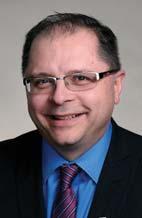
will be too late to prosecute for the mine spill.
Keep it quiet and it will go away?
Get the pipeline going and maybe Alberta will give us some gas at $1.40 a litre. Do your job because there is an election coming.
Warner Bliskis
Prince George
Why are Ontario drivers better than B.C. drivers?
I spoke to my brother and a friend in Toronto and Lindsay. They own two cars each – Audi, Saturn, Subaru and Kia – and they pay less than $900 in total each for car insurance. I own a Subaru Outback and a sports car that is insured for six months a year and I pay over $2,300 for both. Is risk distributed over a greater population?
Northern Ontario driving is similar to B.C, Toronto must get 20,000 new drivers a year that have never seen snow or is it it bureauacracy gone wild?
Doug Willoughby
Prince George
I usually try to stick to uncontroversial matters when I write to The Citizen – you know, like climate change, indigenous rights, Trudeau’s latest follies, etc. – but must comment on the article in Saturday’s paper, “How to make the best batch of biscuits.”
The article is credited to Citizen

SHAWN CORNELL DIRECTOR OF ADVERTISING
Facebook, for example, it’s not clear that the American way is better.
In an ideal world, connections would be global and through social media platforms, and they would operate in countries in which domestic law is the first and last word. For a model, consider Canada’s banking system, embedded in a global financial system but subject to strict rules that spared the country the brunt of the 2008 global financial crisis.
Decisions about what speech would be regulated would be made out in the open, perhaps by an arm’s length agency like the Bank of Canada.
Such proposals may be too much for those who see in government regulation the shadow of totalitarianism. We understand their concerns, but they need to recognize that we already live in a world of unaccountable government action when it comes to content.
Outsourcing our democratic self-government responsibilities to Mark Zuckerberg has had terrible – even genocidal – consequences. Content and speech are always being regulated – the only question is by whom, and in whose interests. We believe that when it comes to our speech, citizens should be the ones to decide, with rules that are set transparently and with accountability.
— Natasha Tusikov is an assistant professor in criminology at York University and Blayne Haggart is an associate professor of political science at Brock University. This article is republished from theconversation.com.
The Prince George Citizen welcomes letters to the editor from our readers. Submissions should be sent by email to: letters@pgcitizen.ca No attachments, please.
They can also be faxed to 250-960-2766, or mailed to 201-1777 Third Ave., Prince George, B.C. V2L 3G7.
Maximum length is 750 words and writers are limited to one submission every week.
We will edit letters only to ensure clarity, good taste, for legal reasons, and occasionally for length.
Although we will not include your address and telephone number in the paper, we need both for verification purposes.
Unsigned or handwritten letters will not be published.
The Prince George Citizen is a member of the National Newsmedia Council, which is an independent organization established to deal with acceptable journalistic practices and ethical behaviour.
If you have concerns about editorial content, please contact Neil Godbout (ngodbout@pgcitizen.ca or 250-960-2759).
If you are not satisfied with the response and wish to file a formal complaint, visit the web site at mediacouncil.ca or call toll-free 1-844877-1163 for additional information.
news service but as it jumps right into extolling the virtues of “white lily flour,” I have grave doubts that anyone from The Citizen had much to do with this article other than snagging it off the wire service.
For, alas, White Lily – sublime biscuit flour that it is – cannot be had in any stores here in P.G., rarely in Canada or nor even easily online.
White Lily is actually a mix of flour, baking soda, baking powder and salt and there are a few brands locally that do similarly. But having spent many an August week in biscuit heaven (southern Ohio) over the past 15 years, I must sadly report that nothing locally is anywhere near the biscuitflour Whte Lily is.
The article is still useful, though announcing itself –“Here’s everything you need to consider” – is also misleading because it neglects to enunciate one of the cardinal rules of tender biscuit-making: go at it gently.
Many folks who are experienced yeast bread makers, but with limited biscuit years, may mix the dough and then automatically begin to enthusiastically bump and thump it around with gleeful animosity and end up with a product useful only as a projectile to hurl at the heads of unwanted guests.
To make a beautiful light biscuit, one must handle the dough more benignly than you would a newborn babe, cuddling it affectionately, softly talking it into taking on the desired shape, rather than
Mailing address: 201-1777 Third Ave. Prince George, B.C. V2L 3G7
Office hours: 9 a.m. to 5 p.m., Monday to Friday
General switchboard: 250-562-2441 info@pgcitizen.ca
General news: news@pgcitizen.ca
Sports inquiries: 250-960-2764 sports@pgcitizen.ca
Classifieds advertising: 250-562-6666 cls@pgcitizen.ca
acting as if f you were hammering out dents in a fender at an auto body shop. There are vague hints at this issue here and there in the article, but it’s overly subtle. Seriously folks: you need to cultivate tenderness in yourself if you would have your biscuits be likewise.
Oh, and one more quibble: you do not, as the article implies, face the Manichean choice between flaky or fluffy. If you practice diligently (seven years would be a good target time for apprenticeship) you can have your fluff and flake it, too.
Norman Dale Prince George
It’s not often we feel the warmth from a decision made right.
Prince George Canadian Tire dealer Selen Alpay picked up the tab for his store employee, Rose Renner, to attend the Special Olympics – not in Burnaby or Quesnel but in Abu Dhabi. And it wasn’t coincidental that Rose’s sister, Linda, became a multi-medal winner while there.
If the Employer of the Year recognition is still given by the Prince George Chamber of Commerce, could I humbly suggest that Selen Alpay be shortlisted for it?
Mr. Alpay is truly “one of the great things about Prince George.” With enormous respect (and no little bias!) as the retired Canadian Tire dealer in Prince George. Tom Steadman Bracebridge, Ont.
Shawn Cornell, director of advertising: 250-960-2757 scornell@pgcitizen.ca Reader sales and services: 250-562-3301 rss@pgcitizen.ca Letters to the editor: letters@pgcitizen.ca
Website: www.pgcitizen.ca
Website feedback: digital@glaciermedia.ca
Member of the National Newsmedia Council A division of Glacier Media


One morning last fall, four-yearold Joey Wilcox woke up with the left side of his face drooping. It was the first sign of an unfolding nightmare.
Three days later, Joey was in a hospital intensive care unit, unable to move his arms or legs or sit up. Spinal taps and other tests failed to find a cause. Doctors worried he was about to lose the ability to breathe.
“It’s devastating,” said his father, Jeremy Wilcox, of Herndon, Va. “Your healthy child can catch a cold – and then become paralyzed.”
Joey, who survived but still suffers some of the effects, was one of 228 confirmed victims in the U.S. last year of acute flaccid myelitis, or AFM, a rare, mysterious and sometimes deadly paralyzing illness that seems to ebb and flow on an every-other-year cycle and is beginning to alarm public health officials because it is striking more and more children.
Dr. Anthony Fauci, head of the U.S. National Institute of Allergy and Infectious Diseases, said it may bear similarities to polio, which smouldered among humans for centuries before it exploded into fearsome epidemics in the 19th and 20th centuries.
Fauci, who published a report about the disease Tuesday in the journal mBio, said it is unlikely AFM will become as bad as polio, which struck tens of thousands of children annually before a vaccine became available in the 1950s.
But he warned: “Don’t assume that it’s going to stay at a couple of hundred cases every other year.”
While other countries have reported cases, including Canada, France, Britain and Norway, . outbreaks have been more pronounced. More than 550 Americans have been struck this decade. The oldest was 32. More than 90 per cent were children, most around four, five or six years old.
Most had a cold-like illness and fever, seemed to get over it, then descended into paralysis. In some cases it started in small ways – for example, a thumb that suddenly wouldn’t move. Some went on to lose the ability to eat or draw breath.
Many families say their children have regained at least some movement in affected limbs, but stories of complete recovery are unusual. Health officials cannot say how many recovered completely, partly or not at all, or how many have died, though the Centers for Disease Control and Prevention says deaths are rare.
Scientists suspect the illness is being caused chiefly by a certain virus that was identified more than 55 years ago and may have mutated to become more dangerous. But they have yet to prove that.
And while doctors have deployed a number of treatments singly or in combination – steroids, antiviral medications, antibiotics, a blood-cleansing process – the CDC says there is no clear evidence they work.
Many parents say that when

they first brought their child to the emergency room, they quickly realized to their horror that the doctors were at sea, too.
“Everyone is desperate for some magical thing,” said Rachel Scott, a Tomball, Texas, woman whose son Braden developed AFM in 2016 and has recovered somewhat after intensive physical therapy but still cannot move his right arm and has trouble swallowing and moving his neck.
A growing number of experts agree that physical therapy makes a difference.
“These kids can continue to recover very slowly, year over year... It’s driven by how much therapy they do,” said Dr. Benjamin Greenberg of UT Southwestern Medical Center in Dallas, one of the nation’s foremost experts on the condition.
Wilcox, Joey’s father, said his son made huge improvements that way. Joey can run and use his arms. Still, muscle tone is weak in his right leg and shoulder, and he still has left-side facial paralysis.
“He can’t completely smile,” his dad said.
Other stories are more tragic.
Katie Bustamante’s son Alex developed AFM in 2016. The suburban Sacramento, Calif., mother realized something was wrong when she asked the boy, then five, why he wasn’t eating his yogurt. Alex replied that his thumb had stopped working and he couldn’t hold his spoon.
That morning was the start of 17 months of hospital stays, surgeries, therapy, and struggles with doctors and insurers to find a way to restore his ability to breathe. It ended one morning last May, when Alex died of complications.
Government officials need to step up, Bustamante said.
“I want them to research it and find the cause, and I want them to


find a way to prevent it,” she said. “This is growing. This shouldn’t be happening.”
More and more experts feel certain the main culprit is an enterovirus called EV-D68, based on the way waves of AFM have coincided with spikes of respiratory illnesses caused by EV-D68. Enteroviruses are a large family of viruses, some of which, such as polio, can damage the central nervous system, while many others cause mild symptoms or none at all.
In the U.S., doctors began reporting respiratory illnesses tied to EV-D68 in 1987, though usually no more than a dozen in any given year. Then, in what may have been one of the first signs of the AFM waves to come, a five-year-old boy in New Hampshire died in 2008 after developing neck tenderness and fever, then weakened arms and deadened legs. The boy had EV-D68, and in a report published in an obscure medical journal,
researchers attributed his death to the virus.
The first real burst of AFM cases hit in 2014, when 120 were confirmed, with the largest concentrations in California and Colorado.
What ensued was an even-year, odd-year pattern: cases dropped to 22 in 2015, jumped to 149 in 2016, and fell again, to 35 in 2017. Last year they reached 228, a number that may grow because scores of illnesses are still being investigated.
In keeping with the cyclical pattern, just four cases have been confirmed this year so far.
CDC officials consider an illness AFM based on scans and other evidence showing a certain kind of damage to the spinal cord. Proof of an enterovirus infection is not required for a case to be counted, mainly because such evidence has been hard to come by. So far, CDC investigators have been able to find evidence of enteroviruses in the spinal fluid of only four of 558
confirmed cases.
Scientists are using more sensitive spinal-fluid tests in hopes of establishing the connection between AFM and EV-D68 more firmly. That, in turn, could spur more focused work on treatments and maybe even a vaccine. Meanwhile, Fauci’s agency has put out a call for researchers to apply for federal funds, and is tapping a University of Alabamaanchored network of pediatric research centres to work on the illness.
The CDC is pledging a greater focus, too. Parents have accused the agency of doing little more than counting cases and have complained that when they tried to contact CDC, they encountered only automated phone trees and form responses.
CDC officials have begun holding meetings and calls with families, set up a scientific task force and working to monitor cases more closely.



Citizen news service
U.S. President Donald Trump threatened to close the U.S.-Mexico border this week if Mexico did not stop all undocumented immigrants from coming into the United States. The United States and Mexico do cooperate already in addressing Central American migration, and, in any event, Mexico cannot stop every undocumented migrant from entering the United States. In practice, Trump’s threat would mean shutting down ports of entry, which would stop legal migrants and commerce from coming into the United States from Mexico.
Mexico is the United States’ third largest trading partner, and over $1 billion in trade goods cross the U.S.-Mexico border every day. But those numbers can seem large and abstract, and so many a media outlet wrote about a more tangible example: the United States would run out of avocados in a matter of weeks if Trump does indeed close the southern border.
But how effective is focusing on one fruit?
Far from trivializing a potential bilateral trade crisis, some experts say that focusing on the avocado helps drive home the impact Trump’s decision would have on American readers.
“The avocado story is not a new one – it comes up all the time with Mexico trade issues,” William Reinsch, who holds the Scholl Chair in International Business at the Center for Strategic and International Studies, wrote in an email.
“It’s a handy shorthand way of illustrating how an abstract issue like international trade actually affects people’s lives day by day... it gets people to understand the interconnectedness of the global marketplace and demonstrates the benefits of globalization. Without it, we’d have to go back to putting butter on our toast,” added Reinsch, who was previously president of the National Foreign Trade Council.
“I think it’s a good example. We need to make U.S.-Mexico trade and trade policy and border management tangible,” agreed Christopher Wilson, deputy director of the Wilson Center’s Mexico Institute.
That said, there are downsides of framing even the economic angle of the U.S.-Mexico border around avocados. For one thing, “Of course there is way more to the U.S.-Mexico economic relationship – there’s way more at stake in shutting down the border than just avocados,” Wilson said. “Sometimes you just have to let the numbers speak for themselves. Sometimes it’s not a perfect little anecdote that encapsulates everything.”
That’s especially true since, while Mexico’s the United States’ third largest trade partner, it’s the second destination for exports, said Jorge Guajardo, Mexico’s former ambassador to China. “The U.S. imports much more from

China than to Mexico,” he said, but it “exports more to Mexico than China, Japan, and Korea combined,” and much of that is in the form of agricultural products. Farmers will feel a closed border, Guajardo argued, especially because Trump’s already in a trade standoff with China.
“Here’s the thing: whether he goes through or not with this nonsense of closing the border, if nothing else, he’s emboldening the Chinese in their negotiation,” Guajardo said.
For another, statistics like these – how quickly U.S. consumers would feel the pressure of a border closure when they go to make breakfast – only capture one part of the U.S.Mexican economic relationship. Roughly half of the trade is comprised of whole products that are sold from one country to another. But the other rough half is of trade is trade in intermediate parts. According to Wilson, over $100 billion in parts come into the United States every year to “keep our factories running.”
While avocados could run out in a matter of weeks, factories, he said, would feel the hit of a border closing in two to three days.
Another potential downside of focusing on avocados is that Trump is framing the issue in terms of security, not economics, Heather Hurlburt, director of the New Models of Policy Change Program at New America, wrote in an email, just as some of his opponents are against his policies not because of guacamole, but on humanitarian grounds. In addition to threatening to close the border, Trump decided to stop sending aid to the Central American countries from which people are fleeing in the first place.
“By claiming that there is a crisis at the border – and maneuvering how they house and treat migrants so that there appears to be one – the president is activating his supporters

to believe that the security situation is so dire it justifies suffering economic consequences,” she wrote. “If the stakes are either crime and violence directed against American citizens, as Trump often and erroneously says (since we know immigrants commit fewer crimes on average than the native-born) or the human suffering of families sleeping on gravel in underpasses because of this administration’s choices, worrying about avocados seems rather silly either way.”
Although Trump is making his argument on security grounds, the reality is that there will be an economic element to a border closure, Wilson said. So it’s an argument that should be made to the U.S. public, in addition to, but not instead of, a conversation on migration, he said.
“I actually think that the economic argument to not shut down ports of entry is an incredibly powerful one. I’m not at all uncomfortable making that argument,” he said.
And Mexico cooperates with the United States on security because of the economic benefits of the relationship, said Guajardo, now a senior director at McLarty Associates.
“It’s not as if Mexico gains much by helping the United States on security issues,” he said. “It’s not necessarily where immigrants want to emigrate to. Nevertheless, Mexico cooperates with the United States because we recognize that we have an economic partnership.
“If you start with this nonsense of closing the border, there’s no longer an argument,” he said.
Which brings us back to avocados.
“(The) specter of trucks of rotting avocados is not a bad metaphor for what happens to a host of US industries if you shut down border crossings,” conceded Hurlburt, who worked in former president Bill Clinton’s White House and State Department.
dex closed up 35.81 points to 16,263.87. In New York, the Dow Jones industrial average was down 79.29 points at 26,179.13. The S&P 500 index was essentially unchanged at 2,867.24, while the Nasdaq composite was up 19.78 points at 7,848.69. Markets appear to be taking a “breather” after posting strong gains as investors await jobs reports that could be a catalyst for action up or down, says Dominique Barker, portfolio manager at CIBC Asset Management. Barker said markets appear to be shrugging off the growing prospect of a hard Brexit in which Britain would retain few ties to the European Union. She said there has been “exhaustion” about the protracted political battle even as some large corporations have suggested they may leave Britain for Europe, hurting thousands of British jobs. A hard Brexit could lead to a British recession with European markets falling three to five per cent and North American markets dipping two to three per cent, Barker said in an interview
The TSX rose on gains in consumer staples stocks such as Metro Inc., along with telecommunications. Materials was the third-best sector led by gains for Turquoise Hill Resources Ltd. and Barrick Gold Corp. as the price of gold rose with the June gold contract up US$1.20 at US$1,295.40 an ounce. The May copper contract was down 1.9 cents at US$2.91 a pound. The energy sector fell, led by Encana Corp. and Crescent Point Energy Corp., despite higher oil prices. The May crude contract was up 99 cents at US$62.58 per barrel. The increase came after the U.S. moved to break up a group of Iranian-linked companies that has transferred around US$1 billion to Iran in violation of sanctions. The May natural gas contract was down 2.4 cents at US$2.68 per mmBTU.
The Canadian dollar traded at an average of 74.94 cent US compared with an average of 74.98 cents US on Monday.
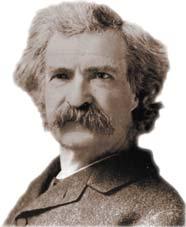

Ted CLARKE Citizen staff
tclarke@pgcitizen.ca
Get ready for Round 4 Prince George. The Spruce Kings are going to the B.C. Hockey League final.
Ben Poisson made sure of that when he scored the winner 18:49 into overtime to give the Spruce Kings a 3-2 win over the Victoria Grizzlies a compete the sweep of the Grizzlies in the Coastal Conference championship Tuesday night in Victoria.
Poisson stole the puck from Victoria forward Charlie Campbell just outside the Grizzlies’ blueline and broke into the zone and launched a hard wristshot that found the net behind goalie Kurtis Chapman.
The Spruce Kings will await the winner of the Interior Conference championship and will host Game 1 of that series on Friday, April 12 at Rolling Mix Concrete Arena.
Liam Watson-Brawn and Layton Ahac scored in regulation time for Prince George. Alex Newhook had both goals for the Grizzlies in the opening 60 minutes. Both teams had great chances to end it early in overtime.
Ahac saved a sure-goal at the 1:41 mark when he swatted away a puck that was trickling across the line after Newhook set up Campbell in front of the net. Ahac nailed the goalpost 3:50 in, on a setup in the slot from Chong Min Lee. The Kings dominated the puck in the extra session and outshot the Grizzlies 13-8.
After three consecutive 4-2 losses to the Kings, for the first time in the series the Grizzlies did not look like they were skating on tired legs until the teams got to overtime, when the Kings took over the game.
The Grizzlies scored two power-play goals in the second period to take a 2-1 lead. Watson-Brawn had opened the scoring for Prince George 72 seconds into the
Prince George Spruce Kings vs. Victoria Grizzlies (Spruce Kings win best-of-seven series 4-0)
Game 4
Tuesday’s summary Spruce Kings 3 at Grizzlies 2 (OT)
First Period No scoring.
Penalties – Noble Vic (holding) 7:38.
Second Period
1. Prince George, Watson-Brawn 2 (Lee) 1:12
2. Victoria, Newhook 10 (Hughes, Johnson) 13:44 (pp)
3. Victoria, Newhook 11 (Bucheler, Johnson) 18:29 (pp)
Penalties – Donaldson PG (cross-checking), Williams PG (kneeing) 11:59, Ahac PG (roughing), Lakoduk Vic (roughing), Guiney Vic (cross-checking), Berger PG (misconduct) 15:28, Vanroboys PG (slashing) 17:43 Third Period
period when he snuck into enemy territory undetected from his defence position and was all alone just outside the crease when Lee directed a low shot at the net from the left side that trickled in off the stick of Watson-Brawn.
The Kings got into penalty trouble and were forced to try to kill off a two-man disadvantage when Sean Donaldson got caught cross-checking and Fin Williams took a kneeing penalty on the delayed call to Donaldson. Prince George was 15 seconds away from killing both penalties when Newhook, the BCHL scoring champion, fired a long wrist shot that got through a crowd in front of goalie Logan Neaton. Neaton protested to the officials that he was interfered with on the play but the goal stood.
The Grizzlies went on the power play again late in the period when Lucas Vanroboys was sent off for slashing goalie
4. Prince George, Ahac 5 (Cozzi, Coyle) 9:40 (pp)
Penalties – Brar PG (roughing), Hughes Vic (roughing) 0:58, PG bench (too many me served by Cunningham) 6:03, Johnson Vic (slashing) 8:11. Overtime
5. Prince George, B.Poisson 10, 18:09
Penalties - None.
Shots on goal by Prince George 10 12 9 13 -44
Victoria 11 7 10 8 -36
Goal – Victoria, Chapman (L,8-7); Prince George, Neaton (W,12-1). Power plays – PG: 1-5; Vic: 2-3.
Referees – Trevor Nolan, Graedy Hamilton; Linesmen – Marko Casavant, Jordan Wood.
Attendance – 1,051.
Scratches – Victoria: F Marty Westhaver (upper-body injury), F Jake Veilleux (healthy); Prince George: F Spencer DenBeste (healthy), F Tyler Schleppe (healthy), F Craig MacDonald (healthy), D Jason Chu (healthy).
Chapman, who got away with a retaliatory punch at Vanroboys that went unpenalized. Newhook scored the go-ahead goal at 18:29, his 11th of the playoffs, finding the top corner with another long wrister.
The Kings tied it 2-2 with a power-play goal, 9:40 into the third period. Grizzlies defenceman Kenny Johnson was in the box for taking a hack at Neaton. The Kings gained the zone and Patrick Cozzi’s shot was deflected but Ahac jumped on the loose puck in the slot and lifted a shot high in behind Chapman.
Neaton came up with a game-saving stop with about three minutes left in the third period when he poked the puck off the stick of Riley Hughes on a partial breakaway.
Kings captain Poisson had the best chance to end it in the final minute of regulation time when he got the puck at the side of the net but failed to get a shot away.
Neither team scored in the first period.
The Grizzlies came close 12 minutes in when Kyle McGrath used his speed to get free on a breakaway. McGrath tried to go to Neaton’s blocker side but the 19-year-old netminder from Brighton, Mich., got his shoulder in the way.
A couple minutes later, Kings defenceman Dylan Anhorn tested Chapman with a deke through the slot and in the final minute of the period Nolan Welsh got free in alone with the puck but shot high. The win extended the Kings’ playoff winning steak to nine games and they’re now 12-1 in the postseason, having won 20 of their last 22 games. A sparse crowd of just 1,051 showed up to watch at the Q Centre, which has a seating capacity of about 2,700. In the Interior championship Tuesday in Vernon, the host Vipers defeated the Wenatchee 7-2 to take a 2-1 lead in that best-of-seven series. Game 4 is set for tonight in Vernon.
Gemma KARSTENS-SMITH Citizen news service
VANCOUER — Tanner Pearson scored twice, leading the Vancouver Canucks to a 4-2 comeback win over the San Jose Sharks on Tuesday. Markus Granlund and Troy Stecher also put away goals for the Canucks (35-3510), while Bo Horvat and Loui Eriksson each registered a pair of assists. Kevin Labanc and Joe Pavelski scored for the Sharks (45-26-9).
Vancouver goalie Thatcher Demko stopped 33-of-35 shots and Martin Jones had 19 saves for San Jose.
The loss added to a tough stretch for the Sharks, who are 1-8-1 in their last 10 contests and haven’t posted a regulation win since March 12. Vancouver was down 2-1 midway
through the third period, but quick goals from Pearson and Granlund swung the game.
Granlund played hero for the Canucks, completing the come-from-behind victory with a gritty goal 13:39 into the third.
With heavy traffic in front of the San Jose net, the Vancouver centre banged away at the puck and found a way to shovel it in behind a diving Jones.
The Canucks scored on their first shot of the night after Horvat sliced a back pass to Pearson from below the goal line.
The left-winger snapped the puck in past Jones 1:28 into the game.
Labanc responded for San Jose, tipping a long shot from Brendan Dillon in past a diving Demko midway through the first period.
The goal extended Labanc’s point streak to six games, including three goals and three assists.
The Sharks added a power-play goal 10:47 into the frame after Vancouver’s Adam Gaudette was called for hooking.
Tomas Hertl sent a pass down low and Pavelski tipped it in back door.
Tuesday marked Pavelski’s return to the San Jose lineup after missing seven games with a lower-body injury.
Joe Thornton registered assists on both Labanc and Pavelski’s tallies.
The 39-year-old centre now has 1,063 career helpers, tying him with Steve Yzerman for eighth place on the NHL’s all-time assists list.
The Canucks tied the score 10:18 into the third with a controversial marker.
Jones stopped Eriksson’s shot but Pearson fought to knock out the rebound and poked the puck into the net. Officials on the ice initially ruled no goal but the call was quickly overturned. San Jose coach Peter DeBoer challenged
the refs, citing goalie interference. Review in Toronto determined the goal was good, saying the puck was loose.
Stecher added an empty-net goal with a minute and a half left in the game.
The Canucks will battle the Predators in Nashville on Thursday before wrapping their season with a visit to the St. Louis Blues on Saturday.
The Sharks are headed to Edmonton where they’ll face the Oilers on Thursday.
NOTES: Tomas Hertl extended his point streak to five games. He has three goals and four assists across that stretch. ... The Canucks handed out their team awards, giving goalie Jacob Markstrom MVP honours and star rookie Elias Pettersson the title of most exciting player. ... Linesman Lonnie Cameron worked his final NHL game. The Victoria native has been with the league for 23 seasons and officiated 1,554 games.

TORONTO — The Toronto Blue Jays continued their radical roster makeover Tuesday, sending veteran outfielder Kevin Pillar to the San Francisco Giants for three players.
The 30-year-old Pillar, a California native who was the longesttenured Blue Jay, has been in the Toronto organization since being drafted in the 32nd round in 2011.
He has played 695 games for the Jays, hitting .260 with 55 home runs and 231 runs batted in.
In return, the Jays acquired right-handed reliever Derek Law, utility infielder Alen Hanson and right-handed pitching prospect Juan De Paula.
Pillar did not start Monday’s game against Baltimore but delivered a pinch-hit sacrifice fly in a ninth-inning Toronto rally that fell just short in a 6-5 loss.
“It’s definitely an emotional time for me and my family,” a visibly moved Pillar told reporters.
“You spend a lot of time here,” he added. “You spend more time here than you do at your home in the off-season. I spend more time with people here than I do with my own family.”
Known for his fielding prowess, Pillar was known as Superman for his ability to climb high to get balls in the outfield. He is a three-time Gold Glove Award finalist (2015, 2016, 2017) and earned the 2015 Wilson Defensive Player of the Year for centre field.
He thanked the Toronto fans for their support.
“I got called up as a 24-year-old kid that had no intentions of getting to the big leagues... I’m leaving here as a 30-year-old man with a wife and a kid. Just a lifetime of memories.
“I’m not Superman... This city and this country kind of allowed me to almost become kind of a mythical kind of superhuman baseball player and I can’t thank them enough for that.”
Hours after the trade, the Blue Jays recalled outfielder Anthony Alford from triple-A Buffalo. Pillar, who is making US$5.8 million this season, is eligible for free agency after the 2020 season.
He joins Russell Martin, Marco Estrada, Troy Tulowitzki, Kendrys Morales, Josh Donaldson, Steve Pearce, J.A. Happ and Yangervis Solarte, all of whom have left in a Toronto teardown that started last season.
De Paula, 21, is a minor leaguer ranked 19th among Giants’ 30 prospects by MLB Pipeline.
He started last season with the Class-A Staten Island Yankees before being acquired by the Giants in the Andrew McCutchen trade. He was then assigned to the ClassA Augusta GreenJackets.
The six-foot-three 165-pounder had a 1.72 ERA with 55 strikeouts and 27 walks over 52.1 innings of work last year. A native of Santo Domingo, Dominican Republic, De Paula has a career 13-14 record and 2.47 ERA in 48 minor league games.
The 26-year-old Hanson hit .252 with 17 doubles, five triples, and eight home runs across 110 games for the Giants last season. The six-foot, 170-pound switch-hitting
infielder has a career .238 batting average, with 27 doubles, eight triples, 12 home runs, and 51 RBIs over 243 games.
The 28-year-old Law had a 7.43 ERA across 13.1 innings with 12 strikeouts and eight walks for the Giants in 2018.
Over the last three seasons with San Francisco, the six-foot-three, 215-pounder has a 9-3 record with a 3.83 ERA and 97 strikeouts in 105.2 innings.
Last season, Pillar hit .252 with 40 doubles, 15 home runs, and 18 walks over 142 games in 2018.
“This one hurts,” tweeted Jays pitcher Marcus Stroman. “Been my locker-mate since 2014. Going to be crazy not having you there. Love you bro. Hope this move brings you joy and happiness for you and your family!”
The Blue Jays also completed a separate deal, acquiring Socrates Brito from San Diego in exchange for outfielder Rodrigo Orozco. The Padres had claimed Brito off waivers on March 27.
The 26-year-old Brito hit .175 with one home run and three RBIs across 24 games for the Arizona Diamondbacks in 2018. The native of the Dominican Republic, has a career .202 batting average in 82 games.
Orozco, 24, spent last season with the Advanced-A Dunedin Blue Jays, where he hit .304 in 112 games. He hit .283 with 108 extra-base hits and 163 RBIs in 399 games over six minor-league seasons.
Brito was added to the majorleague roster with outfielder Dalton Pompey shifted to the 60-day injured list with a concussion.
Gregory STRONG Citizen news service
LETHBRIDGE, Alta. — Niklas Edin was about to enjoy a swig of coffee during a mid-game break at the world men’s curling championship when he noticed a photographer had stopped to capture the moment.
The brew was from a popular domestic chain.
Edin gave the photog a knowing nod and smile before taking a gulp.
The Swedish skip feels quite comfortable making the most Canadian of poses. It’s not a surprise considering how often he’s in this country.
“I’m spending 120 to 150 days a year here and I’m closing in on 100 (trips) to Canada now,” Edin said Tuesday.
“So it definitely feels like a second home.”
A regular on the domestic Grand Slam circuit, some of Edin’s biggest curling moments have come on Canadian ice.
He made his Olympic debut at the 2010 Vancouver Games and led the first non-Canadian men’s team to win a Slam when his crew took the 2016 Masters in Okotoks, Alta.
The 33-year-old from Karlstad also won two of his three world titles in Canada. He beat Canada’s Brad Jacobs for the 2013 crown in Victoria and topped Norway’s Thomas Ulsrud to win two years later at Halifax.
“I think the championships are the ones you remember the most,” Edin said.
“The two wins here on Canadian soil – I think it’s pretty rare that non-Canadian teams win the worlds in Canada.
“So it’s definitely a big confidence boost, especially going into this one knowing that we’ve won two of them (here).”
Edin settled for world silver against Canada’s Brad Gushue in 2017 at Edmonton. He avenged the loss in last year’s final at Las Vegas.
The fifth-ranked skip is among the favourites this week at the Enmax Centre.
Edin opened with five straight round-robin victories before dropping a 6-5 decision to Scotland’s Bruce Mouat on Tuesday morning.
“We’re getting easy wins with no (10-end) games until the sixth game,” Edin said.
“I think pretty much everything is good so far.”
Edin’s first significant international title also came in Canada. He was 18 when he won the

2004 world junior championship in Trois-Rivieres, Que.
“I don’t really remember much from the competition itself but I remember the feeling,” he said.
“It was a really great feeling. That was kind of the start to my career at least. We were rolling pretty well after that.
“We got a huge confidence boost showing that we could win those big ones.”
He’s in his third season with the foursome of third Oskar Eriksson, second Rasmus Wrana and lead Christoffer Sungren. Sweden and Japan’s Yuta Matsumura, who needed an extra end to get by South Korea’s SooHyuk Kim 8-7, were at 5-1. Canada’s Kevin Koe improved to 6-0 after posting a 7-4 win over Germany’s Marc Muskatewitz in afternoon play. Koe scored three in the sixth end and ran Muskatewitz out of rocks in the 10th.
Switzerland’s Peter De Cruz (6-0) kept pace with the Calgary skip with a 7-4 victory over American John Shuster, who fell to 4-2.
Italy’s Joel Retornaz (3-2) dumped Norway’s Magnus Ramsfjell 10-4 in morning play. Ramsfjell rebounded in the afternoon with a 9-4 victory over Jaap Van Dorp of the Netherlands (2-4).
Russia’s Sergey Glukhov defeated China’s Qiang Zou 7-1 in the other afternoon game. Scotland was 2-3, Russia improved to 2-4, while China joined Germany and Norway at 1-5.
South Korea (0-6) was the lone winless team entering Draw 11. Round-robin play continues through Friday night. The six-team playoffs begin Saturday and the medal games are set for Sunday.
Citizen news service
Andres Serrano has been quietly stockpiling buttons, baked goods, liquor bottles, slot machines, sports memorabilia, menswear and magazine covers.
For almost a year, his tremendous collection effort has taken him to the front row of high-end auctions and to the far reaches of eBay. The artist best known for his 1987 Immersion (Piss Christ), an amber-hued image of a crucifix submerged in a glass container of his own urine, has spent more than $100,000 amassing a treasure trove of more than 1,000 objects.
Each item bears some relationship to U.S. President Donald Trump. They include souvenirs from his hotels and casinos, as well as merchandise from his 2016 presidential campaign. They include Trump Vodka, Trump Steaks and remnants of Trump Shuttle. They include a Trump University diploma and a fake dollar bill depicting Hillary Clinton behind bars, to which Trump affixed his signature at a Florida rally.
“Trump everything,” the divisive New York-based artist, whose creations have been vandalized at museums across the world and reviled in Congress, said. “I wanted to paint a portrait of Donald Trump using his own brushes.”
The untraditional presidential portrait is set to be revealed April 11 at a still-undisclosed location in Manhattan.
The installation, titled The Game: All Things Trump, is an image of the president rendered in his varied acts of salesmanship and self-promotion. It is a Trump readymade, in the model of Marcel Duchamp, the 20th-century pioneer of avant-garde art. By carefully cataloguing the artifacts as if in a natural-history museum, the exhibition is also a study of the United States as a competitive, acquisitive and fame-obsessed society. Intentionally or not, The Game: All Things Trump helps answer the question that stumped pundits and defied polls: how did Trump become president?
“I’ve always said I don’t make art about art” said Serrano, whose work aims to fuse the sacred and the profane, in his first public remarks about the exhibit. “I make art about things that everyone knows about. It’s only natural that it’s now Trump.”
The show’s title is drawn from Trump: The Game, a 1989 board game released by Milton Bradley Co., with the tagline, “It’s not whether you win or lose, but whether you win!”
“That has been the Donald Trump attitude all his life,” said Serrano, 68, who was born in New York – four years after the president – to an immigrant father from Honduras and a mother of Afro-Cuban descent.
The boom-or-bust mentality espoused by the president, the artist said, has been

central to the pursuit of the American Dream, which Trump declared “dead” at his presidential launch in June 2015. Before it died, a dreamlike sense of possibility guided Serrano’s own path. He dropped out of high school when he was 15, entered the Brooklyn Museum Art School when he was 17, spent his later teen years and much of his 20s addicted to drugs and then “came out of it and became the artist that I thought I was supposed to be.”
The president’s life, too, embodies an American ideal – in a different sense.
“When I was in my 20s, I was a drug addict,” Serrano said. “When he was in his 20s, he already owned a lot of things.”
The Trump-branded commodities, the artist believes, are an index of the president’s beliefs and aspirations. In Serrano’s eyes, they reveal how Trump’s quest to identify himself with the country – to cast himself as an American hero – began long before he undertook a bid to lead it.
“Ever since the ‘80s, Donald Trump has been associating himself with a particular vision of American success and making products that paint him as all-American,” Serrano said.
The first object that the artist acquired for the installation was a red-and-white-striped Donald J. Trump Signature Collection tie.
The second and third were buttons from the 2016 campaign. All together, the collection documents the president’s vast commercial empire – among the many features
distinguishing the 45th president from his predecessors. One of them, Jimmy Carter, famously placed his peanut farm in a blind trust during his presidency to avoid possible conflicts of interest.
When it emerged in February that Serrano had purchased a chocolate truffle cake, handed out as a souvenir at Trump’s 2005 wedding, the art world buzzed with speculation about what the artist, whose photographs often feature violence and desecration, had in store for the confectionery delight.
Cedric Barberet, formerly the executive pastry chef at Mar-a-Lago, was curious, too.
“I’m worried about what will happen with what I created,” he said at the time.
But all Serrano did to the miniature cake, which he purchased in an auction for $1,880, was build a refrigerated cube for it.
“I’m not doing anything to these products,” he said. “That’s the beauty of them –they speak for themselves.”
The exhibition neither glorifies nor condemns the president. Serrano, who first photographed Trump for his 2004 America series, doesn’t pass moral judgment on his subject.
“I’m not interested in pointing figures, because I think it’s boring,” he said. “I’ve seen a lot of artwork that’s anti-Trump, and frankly it’s not good, it’s not interesting. I’d rather let the man speak for himself.”
This is a fitting aim for an artist who has never been especially involved in the politi-
Citizen news service
Chances are, if you’ve never tuned into the talk show The View, you have heard about it. Legendary journalist and creator Barbara Walters had one goal in mind in 1997: gather together a panel of multi-generational women around a table to discuss hot topics of the day.
What she got was highly successful and groundbreaking morning television, wrapped up in an intricate web of drama.
In Ladies Who Punch: The Explosive Inside Story of The View, award-winning journalist Ramin Setoodeh offers readers a backstage look of what really went on behind-the-scenes of the transformative talk show.
With unprecedented access with nearly every host, Setoodeh paints a vivid and informative picture of the highs and lows of the last 20 years from several different perspectives.
The show’s beginnings are chronicled through Walters’ viewpoint. From auditioning the inaugural hosts to pioneering an ideal rhythm for the show, Walters had a lot on her plate juggling her new job and other duties at ABC. Even when executives and critics said it couldn’t be done, Walters triumphed with the help of broadcast journalist Meredith Vieira, attorney Star Jones, comedian Joy Behar and rookie Debbie Matenopoulos. Together, the women changed daytime television. Although the idea of the show was an accomplishment, everyday operations were never smooth. Matenopoulos was let go for being too green. Jones insisted the show revolve around her pending wedding.
And eventually, Vieira left, leaving a handful of spots to fill. Enter Rosie O’Donnell. Collectively, O’Donnell spent two seasons on The View, but her stint produced many of the most memorable moments on the show. During O’Donnell’s part in the book, Setoodeh tackles her rivalry

Ladies Who Punch: The Explosive Inside
Ramin Setoodeh takes viewers
with Donald Trump, her on-air cat fight with Elisabeth Hasselbeck, and the turmoil she caused among producers and directors. When she left, a new powerhouse took over in the curious form of movie actress Whoopi Goldberg. Goldberg’s point-of-view in the book describes her steady hand that ushered in a new era. Once Walters retired, Goldberg became a new force with which to be reckoned.
And she still helms the ship today. With a random array of hosts and plenty of drama to go around, Setoodeh manages to peel back the composed facade of what viewers see on their screens in order to focus on raw feelings and teetering emotions of those closely involved with The View.
Ladies Who Punch is an exciting read that proves there’s always a little soap opera even if a show presents itself as hard news.
cal process, as he readily admits, despite being “engaged by the circus that we see in American politics now.”
He has only voted twice in his life – for Barack Obama in 2008 and again in 2012 –and he doesn’t plan to vote again.
“He seemed pretty good, and so I felt like just out of loyalty to the race, I had to support this black president,” Serrano said. The possibility of another breakthrough in 2020 – the first female president, the first black female president, the first openly gay president – wouldn’t motivate him in the same way, he said.
Asked whether he thought Trump was a good president, he demurred.
“I think he’s Donald Trump, and that says it all,” Serrano observed. “It says that he’s always been good at selling things, particularly himself. And he’s done it once again.”
The rest of the objects were merely assembled by him. Serrano likes the idea that other people, such as the former Mar-a-Lago pastry chef, could go around the exhibit and say, “I did that. I did that.”
Meanwhile, viewers will find in the objects figments of their previous connections to Trump – whether they watched him on The Apprentice, gambled at his casinos, bought his vodka or even went to Trump University. They are part of his rise, Serrano said. He thinks Trump would like the show, too. “It’s all about him,” the artist said. “I couldn’t have done it without him.”





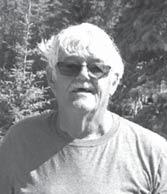
VALAIRE,John February26,2019
JohnValairepassedawayafteralongillness.Heis survivedbyhissonanddaughter,nieces,nephews, andgreat-niecesandnephews.Heispredeceasedby hisparents,brothers,andsister.Johnspenthislife inservicetoothers,hecolouredtheirworldswith splashesofdebate,poems,meditation,stories,and songsdaily.Johnwasanenigmaticpresencewho willbesorelymissed. "ThemountainsarecallingandImustgoandIwill workonwhileIcan,studyingincessantly." Ihavelovedyouwithaneverlastinglove;thereforeI havecontinuedmyfaithfulnesstoyou-Jer.3:13



Adult & Youth Newspaper Carriers Needed in the Following areas:
• Hart Area
Driftwood Rd, Dawson Rd, Seton Cres,
Austin Rd.



Wayne Brade September 26, 1954March 31, 2019
We regret to inform family and friends about the sudden passing of Wayne after a long battle with COPD. Survived by his loving wife Deanna, sons Jason and Chad, grandchildren, Mom-Gay, brothers Gary and Brett, sister Gail. His big loving heart and sense of humour will be missed immensely by everyone who new him! Celebration of Life to be held April 6th, 2019. Drop in 12:00 - 4:00 pm at 7775 Sabyam Rd, Prince George.
ARTHUR (FRANK) HARMON 1945-2019
Beloved husband, father, brother, grandfather and friend. Frank passed away peacefully on Sunday morning, surrounded by his family. He leaves to mourn his wife Lorraine, daughters Leah (Andy), Sharmon (Dean) and son Frank (Michelle). He also leaves his brother Clarence as well as grandchildren, nieces, nephews and so very many friends. Please join us as we celebrate Frank’s life on Saturday, April 6th, from 1:00 - 5:00pm at the Hart Pioneer Centre, 6986 Hart Hwy, Prince George, BC.
Established Franchise Photography Business Serving Northern B.C for over 35 years
Gross Revenues of $150.000 plus annually from seasonal work Lots of opportunity to expand the business.
Transition support available to the right buyer
Serious Enquiries Only Office 250-596-9199 Cell 250-981-1472
Established Franchise Tax Preparation BusinessMackenzieservicing and McLeod Lake area for over 30 years.
Gross Revenues of $85,000 to $90,000
Annually and Potential to expand revenues in a growing economy. Transition support available for the right buyer.
Serious Inquires Only Office (250)997-9003 Home (250)997-5538 Cell (250)990-0152 BUSINESS OPPORTUNITY


• Lakewood • Pilot, Limestone, Mica, Nelson, Selwyn, Valley, Urquhart, Quartz, Azure, Elkhorn Pl & Cres, Ochakwin, Bowren, Chingee Ave, Dome Ave, Cascade Ave, Delta Pl, Jackpine, Quentin Ave.
• • Lower College Heights • O’Grady Rd and Park, Brock, Selkirk, Oxford, Simon Fraser,Trent, Fairmont, Guelph, Gladstone,Hartford, Harvard, Imperial, Kingsley, Jean De Brebeuf Cres, Loyola, Latrobe, LeicesterPl, Princeton Cres, Prince Edward Cres, Newcastle, Melbourne, Loedel, Marine Pl, Hough Pl, Guerrier Pl, Sarah Pl, Lancaster, Lemoyne, • • Upper College Heights • St Barbara, St Bernadette, Southridge, St Anne Ave, Bernard, St Clare St, St Gerald Pl, Creekside, Stillwater.
• • KGV Area
•
• Wainwright St, Burden St, Irwin, Harper, 1st, 2nd, Douglas, Hammond,Nechako Dr, Carney, Douglas, Melville, Tofield, Alward, Ewert St, Freeman St, Gillett St, Laurier Cres
or















































